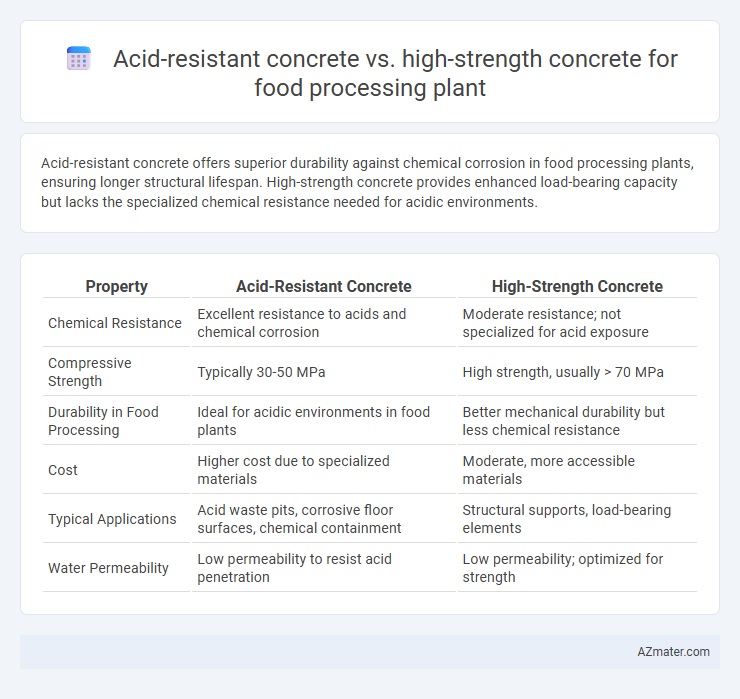Acid-resistant concrete offers superior durability against chemical corrosion in food processing plants, ensuring longer structural lifespan. High-strength concrete provides enhanced load-bearing capacity but lacks the specialized chemical resistance needed for acidic environments.
Table of Comparison
| Property | Acid-Resistant Concrete | High-Strength Concrete |
|---|---|---|
| Chemical Resistance | Excellent resistance to acids and chemical corrosion | Moderate resistance; not specialized for acid exposure |
| Compressive Strength | Typically 30-50 MPa | High strength, usually > 70 MPa |
| Durability in Food Processing | Ideal for acidic environments in food plants | Better mechanical durability but less chemical resistance |
| Cost | Higher cost due to specialized materials | Moderate, more accessible materials |
| Typical Applications | Acid waste pits, corrosive floor surfaces, chemical containment | Structural supports, load-bearing elements |
| Water Permeability | Low permeability to resist acid penetration | Low permeability; optimized for strength |
Introduction to Concrete Selection in Food Processing Plants
Acid-resistant concrete is essential in food processing plants exposed to acidic substances, offering enhanced durability and chemical resistance compared to standard mixes. High-strength concrete provides superior structural integrity, supporting heavy machinery and load-bearing applications while maintaining durability under operational stresses. Selecting the appropriate concrete involves balancing chemical resistance requirements with mechanical strength demands to ensure longevity and safety in food processing environments.
Defining Acid-Resistant Concrete: Key Features
Acid-resistant concrete for food processing plants is specifically formulated to withstand corrosive environments caused by acidic substances commonly found in such facilities. It features chemical-resistant aggregates, low permeability, and additives like silica fume to enhance durability against acid attack, preventing surface degradation and structural damage. This contrasts with high-strength concrete, which prioritizes compressive strength but may lack the specialized chemical resistance needed for long-term performance in acidic conditions.
Understanding High-Strength Concrete: Characteristics and Uses
High-strength concrete, characterized by a compressive strength exceeding 6,000 psi, provides exceptional durability and structural integrity essential for food processing plant infrastructure. Its dense microstructure resists wear and mechanical stress, ensuring long-term performance under heavy equipment loads and frequent cleaning cycles. While acid-resistant concrete offers specialized chemical protection, high-strength concrete is vital for foundations, columns, and beams requiring superior load-bearing capacity and enhanced service life.
Chemical Exposure in Food Processing Environments
Acid-resistant concrete offers superior protection against chemical corrosion caused by frequent exposure to acidic substances commonly found in food processing environments, ensuring structural integrity and hygiene. High-strength concrete provides enhanced durability and load-bearing capacity but lacks specialized resistance to aggressive chemical agents, making it less suitable for areas with intense chemical exposure. Selecting acid-resistant concrete minimizes maintenance costs and contamination risks, critical for maintaining compliance with food safety standards.
Durability and Longevity: Acid-Resistant vs High-Strength Concrete
Acid-resistant concrete offers superior durability in food processing plants by withstanding corrosive substances such as acids, chemicals, and cleaning agents commonly used in these environments, thereby extending structural longevity. High-strength concrete provides enhanced load-bearing capacity and mechanical strength but may lack the specialized chemical resistance needed for harsh acidic conditions. Selecting acid-resistant concrete ensures optimal longevity and maintains structural integrity in environments with aggressive chemical exposure, while high-strength concrete suits applications prioritizing mechanical performance over chemical durability.
Performance Under Extreme Temperatures and Cleaning Agents
Acid-resistant concrete in food processing plants offers superior durability against harsh cleaning agents and corrosive substances, maintaining structural integrity under frequent exposure to acidic environments. High-strength concrete excels in mechanical performance and load-bearing capacity but may degrade when exposed to aggressive acids and extreme temperature fluctuations common in food industry sanitation processes. Selecting acid-resistant concrete ensures long-term resistance to thermal cycling and chemical attack, preserving hygiene standards and structural safety during rigorous cleaning and operational conditions.
Maintenance Needs and Lifecycle Costs Comparison
Acid-resistant concrete offers superior durability and reduced maintenance needs in food processing plants exposed to corrosive substances, minimizing repair frequency and lifecycle costs compared to high-strength concrete. High-strength concrete provides enhanced load-bearing capacity but may require more frequent maintenance due to susceptibility to chemical damage, increasing long-term expenses. Selecting acid-resistant concrete optimizes lifecycle costs by combining chemical resilience with lower upkeep demands essential for food safety compliance.
Compliance with Food Safety and Hygiene Standards
Acid-resistant concrete offers superior protection against corrosion from acidic food processing chemicals, ensuring long-lasting structural integrity and compliance with stringent food safety regulations such as FDA and HACCP standards. High-strength concrete provides exceptional mechanical durability but may require additional chemical treatments or coatings to meet hygiene standards and resist contamination risks in food environments. Selecting acid-resistant concrete optimizes both durability and sanitation, critical for maintaining hygiene compliance and preventing microbial growth in food processing facilities.
Installation Considerations and Construction Challenges
Acid-resistant concrete requires specialized installation techniques to ensure proper curing and chemical resistance, often involving precise mixing ratios and protective coatings to withstand corrosive food processing environments. High-strength concrete demands careful vibration and compaction during placement to avoid segregation and achieve the desired mechanical properties essential for heavy equipment support. Both types present challenges such as maintaining consistent temperature control during curing and preventing cracks, but acid-resistant concrete additionally necessitates surface treatments to enhance longevity against acidic spills and washdowns.
Choosing the Right Concrete Solution for Food Processing Facilities
Acid-resistant concrete is essential in food processing facilities exposed to corrosive substances, ensuring durability and preventing structural damage from acidic cleaning agents and by-products. High-strength concrete provides superior load-bearing capacity and mechanical performance, ideal for heavy equipment areas and high-traffic zones within food plants. Selecting the right concrete depends on balancing chemical resistance needs with structural demands, optimizing facility safety, longevity, and compliance with food safety standards.

Infographic: Acid-resistant concrete vs High-strength concrete for Food processing plant
 azmater.com
azmater.com